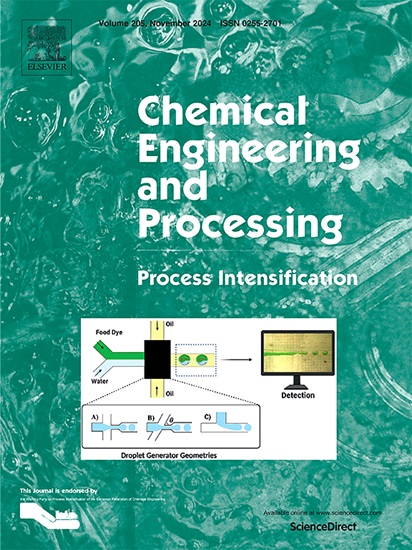Drying of avocado peels using carbonation-ultrasonication as pretreatment: Energy consumption, antioxidant capacity and rheological properties
IF 3.8
3区 工程技术
Q3 ENERGY & FUELS
Chemical Engineering and Processing - Process Intensification
Pub Date : 2024-09-24
DOI:10.1016/j.cep.2024.110004
引用次数: 0
Abstract
Fruit processing by-products, especially peels are underused and mostly discarded as waste. The aim of this study was to assess the effect of ultrasonication (US) combined with carbonation (CUS) on the convective drying process of avocado peels at different temperatures, adding value to this waste. For this, the avocado peels were treated with dry ice for 15 min and subjected to US (400 W/10 min, 30 °C) before convective air drying (50–70 °C). The energy consumption, antioxidant capacity, water adsorption isotherms, rehydration rate, and dynamic rheology of dried avocado peels pretreated by CUS were compared with a control process (without pretreatment) and only US pretreatment. The combined treatment (CUS70) resulted in a 2.6-fold reduction in drying time and a 2.3-fold decrease in energy consumption, with CO2 preserving bioactive compounds and antioxidant capacity after the drying process. Differences were also observed in the rehydration capacity of the samples (CUS), with an increased water absorption capacity, along with a reduction in the viscoelastic properties of the peels. The results present new perspectives for the application of CUS in the food industry, paving the way for the development of creative, innovative, and simple approaches for the management and recycling of agri-food waste, with the potential to extend this knowledge to new food matrices.

以碳酸化-超声波处理为预处理方法干燥鳄梨皮:能耗、抗氧化能力和流变特性
水果加工的副产品,尤其是果皮,利用率很低,大多作为废物丢弃。本研究旨在评估在不同温度下超声波(US)结合碳酸化(CUS)对牛油果皮对流干燥过程的影响,从而增加这种废物的价值。为此,在对流空气干燥(50-70 °C)之前,先用干冰处理牛油果皮 15 分钟,然后进行超声波处理(400 瓦/10 分钟,30 °C)。将经 CUS 预处理的牛油果干皮的能耗、抗氧化能力、水吸附等温线、复水率和动态流变性与对照工艺(无预处理)和仅经 US 预处理的牛油果干皮进行了比较。综合处理(CUS70)使干燥时间缩短了 2.6 倍,能耗降低了 2.3 倍,干燥过程后二氧化碳保留了生物活性化合物和抗氧化能力。此外,还观察到样品(CUS)的再水化能力不同,吸水能力增加,果皮的粘弹性降低。这些结果为 CUS 在食品工业中的应用提供了新的视角,为开发具有创造性、创新性和简便性的农业食品废弃物管理和回收方法铺平了道路,并有可能将这些知识推广到新的食品基质中。
本文章由计算机程序翻译,如有差异,请以英文原文为准。
求助全文
约1分钟内获得全文
求助全文
来源期刊
CiteScore
7.80
自引率
9.30%
发文量
408
审稿时长
49 days
期刊介绍:
Chemical Engineering and Processing: Process Intensification is intended for practicing researchers in industry and academia, working in the field of Process Engineering and related to the subject of Process Intensification.Articles published in the Journal demonstrate how novel discoveries, developments and theories in the field of Process Engineering and in particular Process Intensification may be used for analysis and design of innovative equipment and processing methods with substantially improved sustainability, efficiency and environmental performance.

 求助内容:
求助内容: 应助结果提醒方式:
应助结果提醒方式:


